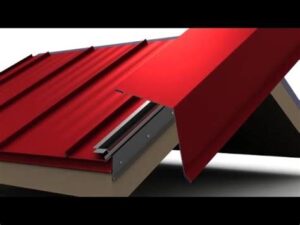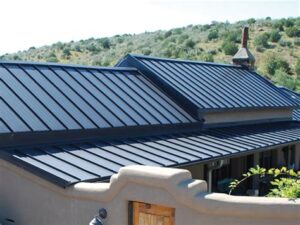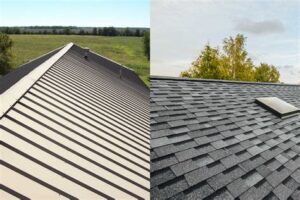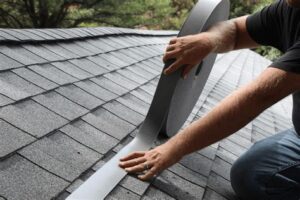When it comes to roofing options, homeowners are often presented with various materials that promise durability and aesthetic appeal. One emerging choice is the oil canning metal roof, a trendy solution that combines modern design with resilience. However, before making a decision, it’s essential to understand the phenomenon of oil canning—characterized by visible waves or distortions in the metal. This article will delve into the intricacies of oil canning, exploring its common features and causes, its impact on your roof’s visual appeal, and the benefits of choosing this unique roofing option. Additionally, we’ll provide insights on minimizing oil canning during installation and discuss the long-term performance this roofing style can bring to your home. Discover if an oil canning metal roof is the right choice for you!
Understanding Oil Canning: Common Features and Causes
Is Oil canning is a phenomenon often discussed in the context of metal roofing. It refers to the visible waviness or distortion that can occur in flat or low-sloped metal panels. Understanding its common features and causes is essential for homeowners considering this type of roofing.
Common Features of Oil Canning
Oil canning typically presents itself in several prominent ways:
- Visual Distortion: The most noticeable feature is the wavy appearance, which can stretch across large areas of the roof.
- No Effect on Performance: Despite its aesthetic drawbacks, oil canning does not compromise the structural integrity or water-tightness of the roof.
- Light Reflection: Depending on light conditions, oil canning may become more or less pronounced, creating varying visual effects at different times of the day.
Common Causes of Oil Canning
Several factors contribute to the occurrence of oil canning in metal roofs:
- Material Tension: The metal panels may experience tension during fabrication or installation, leading to stress that results in warping.
- Temperature Variations: Fluctuations in temperature cause the metal to expand and contract, which can exacerbate existing tensions within the material.
- Improper Installation: Lack of proper fastening techniques or inadequate support can lead to movement and, ultimately, oil canning.
- Panel Width: Wider panels are more prone to oil canning than narrower ones, as the likelihood of warping increases with size.
By understanding the common features and causes of oil canning, homeowners can make more informed choices about metal roofing options. This knowledge further aids in selecting appropriate installation practices to mitigate potential issues.
Is Oil Canning Affecting Your Metal Roof’s Aesthetic Appeal?
When it comes to metal roofing, one of the most frequently observed concerns among homeowners is the presence of oil canning. This phenomenon, which manifests as wavy distortions in the metal panels, can indeed impact the overall visual aesthetic of your roof. However, understanding the implications of is oil canning on aesthetics can help you make informed decisions.
Some homeowners view oil canning as an eyesore that detracts from the sleek, modern look typically associated with metal roofs. The extent of its impact often depends on the color and finish of the roofing material; for instance, lighter hues may make the waviness more noticeable compared to darker shades. Additionally, the type of metal used can also play a role in how oil canning is perceived.
On the other hand, while some may find oil canning unappealing, others might consider it a normal characteristic of metal roofing. Many modern designs aim for a more industrial look, where slight imperfections can add to the character of the home. Thus, opinions on the aesthetic effect of oil canning can vary significantly among homeowners.
If you are particularly concerned about how oil canning may alter your roof’s appearance, it’s advisable to discuss this with your roofing contractor before installation. They can guide you towards materials and techniques that minimize the likelihood of oil canning, helping ensure that your metal roof meets both functional and aesthetic standards.
Evaluating the Benefits of Choosing an Oil Canning Metal Roof
When considering roofing options, many homeowners may find themselves questioning, is oil canning a downside to metal roofs? While the visual effect of oil canning can be a concern for some, there are undeniable benefits associated with oil canning metal roofs that merit discussion.
| Benefit | Description |
|---|---|
| Durability | Oil canning metal roofs are made from strong materials that can withstand harsh weather conditions. They are less likely to crack or become damaged over time compared to other roofing materials. |
| Low Maintenance | With metal roofing, maintenance is generally minimal. Regular inspections and quick repairs can prolong the roof’s life, keeping costs down. |
| Energy Efficient | Metal roofs reflect sunlight, helping to reduce heat absorption. This can lead to lower cooling costs during hot summer months, making them an energy-efficient choice. |
| Variety of Designs | Available in a wide range of colors and styles, oil canning metal roofs can complement any home design aesthetic, enhancing overall curb appeal. |
| Environmental Benefits | Metal roofs are often made from recycled materials and are recyclable at the end of their life, making them a more sustainable option compared to traditional roofing materials. |
While the appearance of oil canning may raise questions for some homeowners, the overall benefits of an oil canning metal roof—such as durability, low maintenance, energy efficiency, design variety, and environmental sustainability—prove that this roofing choice can be advantageous in many respects. Therefore, when deliberating on roofing options, one should consider these benefits alongside any visual concerns.
How To Minimize Oil Canning During Installation
Oil canning is a common concern in metal roofing, but there are several strategies you can employ to minimize oil canning during the installation process. By carefully considering these factors, you can enhance the aesthetic appeal and longevity of your roofing system.
Here are some practical tips for reducing oil canning:
| Strategy | Description |
|---|---|
| Choose Quality Materials | Select high-quality metal sheets that are less prone to warping and distortion. |
| Properly Store Materials | Store metal panels flat on a supportive surface to prevent bending or warping before installation. |
| Control Environment | Install metal roofing in moderate temperatures, as extreme heat or cold can affect the panels’ shape. |
| Secure Fastening | Use appropriate hardware and ensure panels are fastened firmly to minimize movement that can lead to oil canning. |
| Spacing and Alignment | Maintain proper spacing and alignment of panels to allow for thermal expansion and contraction. |
Additionally, working with experienced professionals knowledgeable about oil canning and its implications can further reduce the likelihood of this issue. By taking these proactive measures, you’ll not only improve the installation process but also enhance the overall performance of your metal roof.
Long-Term Results of an Oil Canning Metal Roof for Homeowners
When considering whether Is Oil canning is a concern for your metal roof, it’s essential to evaluate the long-term results that homeowners may experience. Unlike other roofing materials, metal roofs, especially those exhibiting oil canning, can bring some distinct advantages if installed correctly and maintained properly.
One of the most significant benefits is the durability and longevity of metal roofing. Typically, metal roofs can last upwards of 50 years or more—which often outweighs the aesthetic concerns associated with oil canning. Homeowners can enjoy a robust roof that withstands various weather conditions, adding to the overall value of the property.
Additionally, while oil canning can impact visual aspects, many homeowners find that it becomes less noticeable over time. The character of the roof can blend with the natural elements, creating a unique look that complements the home. This shift in perception often mitigates concerns, allowing homeowners to focus on other performance metrics such as energy efficiency.
Energy efficiency is another aspect to consider. Metal roofs reflect solar radiant heat, which can help reduce cooling costs in hot climates. This is especially beneficial in the long run, as homeowners will notice savings on utility bills. Furthermore, many metal roofing options are now available with improved coatings and finishes that enhance energy efficiency while minimizing the visibility of oil canning.
Maintenance-wise, oil canning doesn’t typically affect the structural integrity of a metal roof. However, regular inspections and proper maintenance are crucial. Homeowners must ensure that their roofs are free from debris and that the fastening systems remain tight. By doing so, they can prolong the life of their metal roofs and minimize any potentially exacerbating factors of oil canning.
While the question of Is Oil canning a disadvantage remains, it’s important to weigh these long-term results against the many advantages of having a metal roof. With the right choices, oil canning may not significantly detract from overall satisfaction and utility in the years to come.
Frequently Asked Questions
What is oil canning in metal roofing?
Oil canning refers to the distortion or waviness in the flat areas of metal roofing. It is an aesthetic issue rather than a functional one, often appearing as ripples or bends.
What causes oil canning in metal roofs?
Oil canning can be caused by a variety of factors, including manufacturing processes, thermal expansion and contraction, improper installation, and the inherent properties of the metal itself.
Are there specific types of metal roofing more prone to oil canning?
Yes, thinner gauge metals and certain finishes may be more susceptible to oil canning. Aluminum and steel roofing panels, especially those with a flat profile, can exhibit this issue more than heavier gauge options.
How can I minimize the risk of oil canning when installing a metal roof?
To minimize oil canning, choose heavier gauge materials, select styles with more contour, ensure proper installation techniques, and allow for thermal expansion during installation.
Is oil canning a sign of roofing failure?
No, oil canning is not an indication of roofing failure or a compromise in structural integrity. However, it can affect the aesthetic appearance of the roof.
What should I consider when deciding if a metal roof with oil canning is right for my home?
Consider your home’s architectural style, the importance of aesthetics to you, the local climate, and the potential for temperature fluctuations which could exacerbate oil canning.
Can oil canning be repaired once it occurs?
While oil canning itself is challenging to repair permanently, adjusting installation methods or adding features such as ribs can help reduce its visibility, but it may not completely eliminate it.





